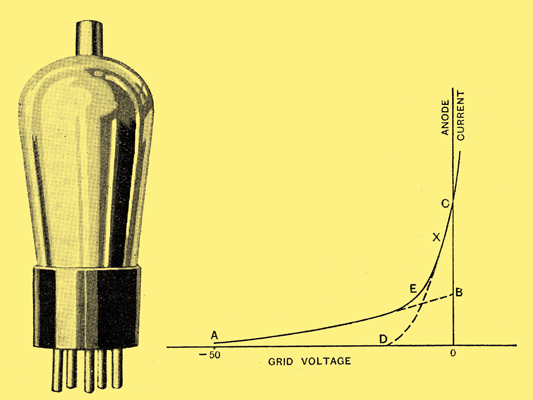|

Characteristics of a typical variable-mu tetrode, the new American screen-grid valve, with which it is claimed that cross-modulation is almost entirely eliminated.
Attempts are often made to control the volume of a receiver by altering the control grid bias of the first screen-grid valve. With this type of valve as hitherto designed there is danger that as soon as the bias is increased negatively beyond, say, 4 Volts, the curvature of the characteristic is sufficiently great to accentuate cross-modulation, and distortion due to an artificial rise in the modulation of the carrier may occur. There is also the likelihood of modulated hum appearing in the case of an all-mains set. This method of controlling volume is, therefore, strictly limited in its application, although in principle it is attractive in that it affords a means of altering amplification without unduly upsetting ganging, and for automatic volume control there would appear to be no substitute.
A new SG valve has appeared on the American market which it is believed will find extensive use in next seasons broadcast receivers. Essentially it contains the elements of two valves within one bulb, but there are only the usual number of contact pins in the base. The valve can, in fact, replace the ordinary screened valve without incurring any change in circuit other than the provision of means to increase considerably the normal negative bias so as to obtain a greater range of volume control. The anode, screen and heater voltages and currents are similar to those of the familiar SG valve.
Referring to the illustration showing a typical characteristic A E C of one of these new valves, it will be seen that there is a long and nearly straight portion E A in which the mutual conductance decreases towards A, and a short, steep portion EC of high mutual conductance. This unorthodox double characteristic is obtained by combining the electrodes of a high mu valve CD with a low-mu type AB in the-same bulb, giving the general characteristic A E C. The new valve is thus called a 'Variable-Mu Tetrode'.
When the bias has the normal value of 1.5 to 3 Volts (working point distant signals of small voltage are given high amplification, but when a local station is tuned in and the bias volume control is adjusted to prevent overloading, the larger signal voltage is easily accommodated on the straight portion EA without rectification and cross-modulation from transmissions on nearby wavelengths. In the De Forest valve, for instance, there is room for a comparatively large signal at a negative bias of 20 Volts, where the mutual conductance has dropped to 0.08 mA/Volt, whilst with the Arcturus 551 model the mutual conductance is 0.005 mA/Volt at 40 Volts negative grid.
In general, it is claimed that cross modulation for a given input is reduced some 500 times when compared with the results of an ordinary screen-grid valve, so much so, in fact, that a single-tuned circuit can he used between aerial and first valve even where the ether is congested, as the selectivity is determined by the overall response of a number of circuits and not by that of the first circuit.
|